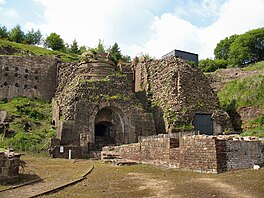Early modern period in Wales

The early modern period in Wales is the period in the history of Wales from 1500 to 1800.
Religion
Following
Welsh Language
In 1567,
In 1588,
| on the |
|---|
| History of Wales |
 |
Calvinism
Bishop Richard Davies and dissident Protestant cleric John Penry introduced Calvinist theology to Wales. Calvinism developed through the Puritan period, following the restoration of the monarchy under Charles II, and within Wales' Methodist movement. However, few copies of Calvin's works were available before the mid-19th century.[4]
Methodist revival
The 18th century also saw the
Wars of the Three Kingdoms
Wales was overwhelmingly
Education
Education in Wales was at a very low ebb in this period, with the only education available being in English while the majority of the population spoke only Welsh. In 1731,

Industrial Revolution
The end of the 18th century saw the beginnings of the Industrial Revolution, and the presence of iron ore, limestone and large coal deposits in south-east Wales meant that this area soon saw the establishment of ironworks and coal mines, notably the Cyfarthfa Ironworks and the Dowlais Ironworks at Merthyr Tydfil.[citation needed]
References
- ^ a b Jenkins, G. H. The foundations of modern Wales p. 7
- ^ ISBN 978-0-7083-1953-6.
- ^ Williams, G. Recovery, reorientation and reformation pp. 322–3
- ^ D. Densil Morgan, "Calvinism in Wales: c.1590–1909," Welsh Journal of Religious History (2009), Vol. 4, p22-36
- ^ Jenkins, G.H. The foundations of modern Wales pp. 347–50
- ^ Peter Yalden, "Association, Community and the Origins of Secularisation: English and Welsh Nonconformity, c. 1850–1930." Journal of Ecclesiastical History 55#2 (2004): 293-324.
- ^ Jenkins, G. H. The foundations of modern Wales p. 5-6
- ^ Davies, J. A History of Wales p. 280
- ^ Jenkins, G. H. The foundations of modern Wales pp. 370–377
